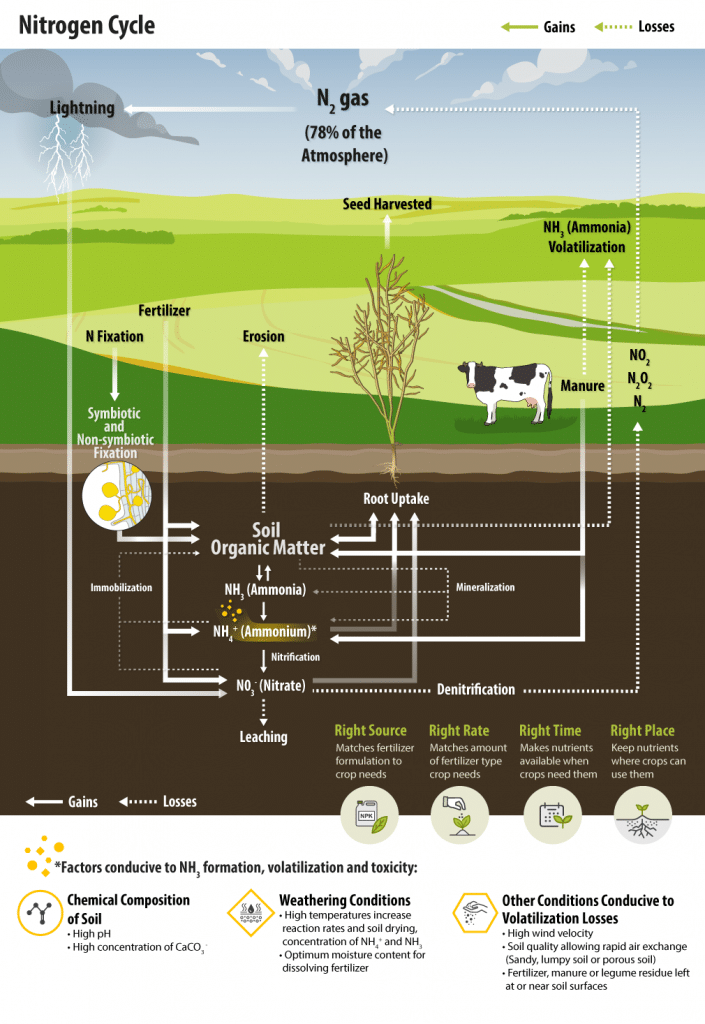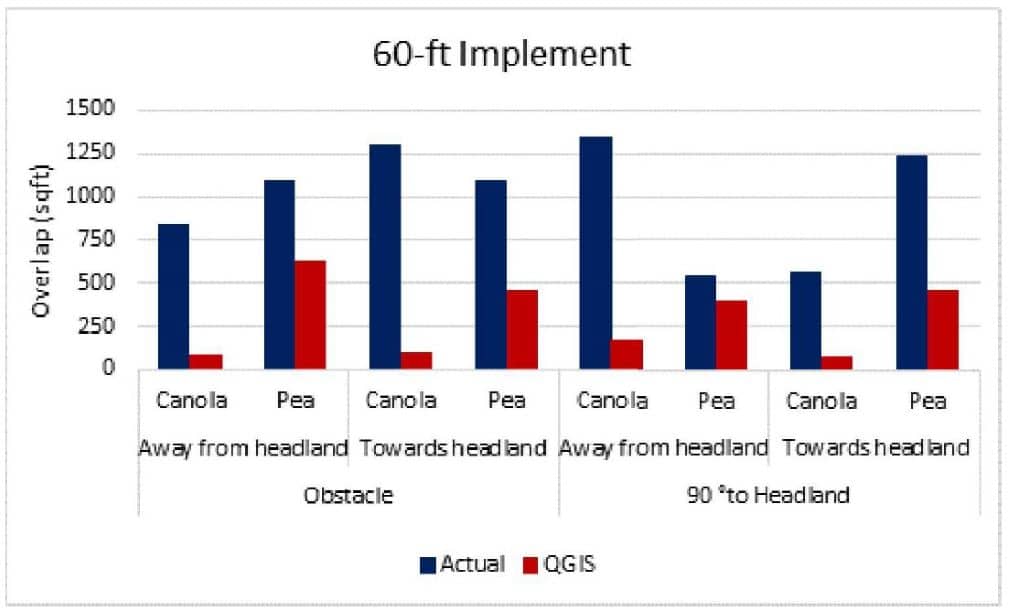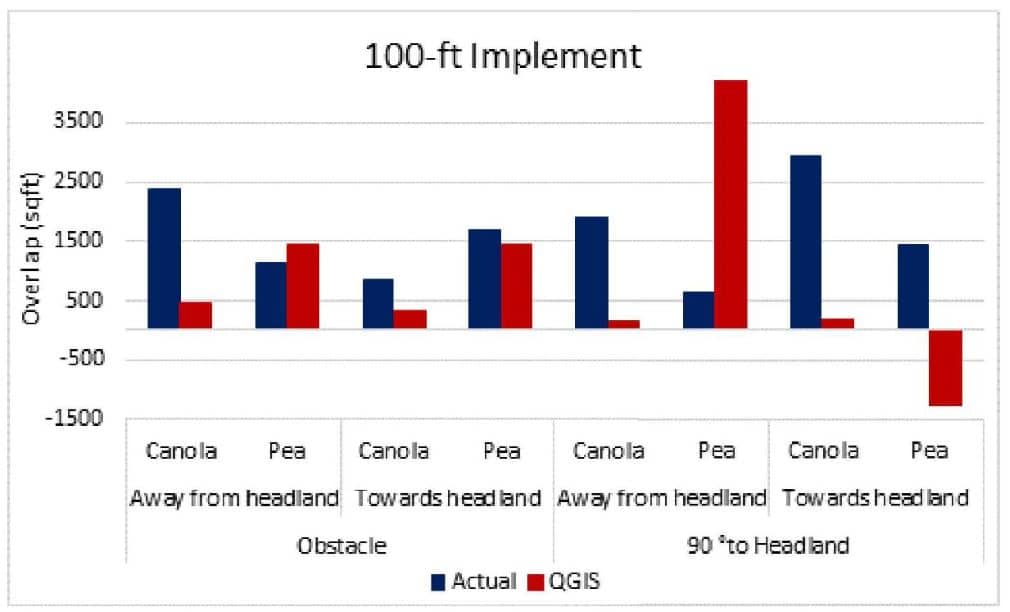Key Result
Though the use of sectional control technology is a tool to help reduce overlap in the field, it is crucial to ensure proper equipment settings prior to seeding to help minimize in-field overlap.
Project Summary
Note – This research was carried out on behalf of the Alberta Pulse Growers.
Background
Overlap control is a crucial element in farm management when considering product (seed, fertilizer), fuel use, time management, and environmental impacts. Advancements in agricultural technology have provided producers with highly efficient equipment to help with on-farm management. With the implementation of global positioning systems (GPS) and auto-steer functions, producers are able to greatly improve efficiencies and better manage overlap while performing field operations. These advancements, along with sectional control technology, have been proven to reduce overlap, and in turn, input costs. Areas with overlapped product are typically found at headlands, around obstacles, associated with the “last pass” of a piece of equipment, or related to manual error. Focusing on overlap reduction in these areas could result in significant cost savings to producers as well as overall environmental benefits.
The approach to every field is unique in terms of obstacles, topography, equipment type, and operator preferences, making it difficult to use one formula across all field types when determining the benefits of using sectional control technology. Field variables, such as size, shape, number of obstacles, and obstacle shape and size will impact the total amount of field overlap.
Input management is a growing priority in agricultural production, and increasing productivity is key to maximizing profit. Historically, to increase productivity, wetlands have been drained, treelines removed, and the natural landscape has been disrupted to improve farming efficiencies. However, with advanced agricultural technologies, these areas can now be left undisturbed. The ability to retain wetlands and diverse natural areas while still managing a productive farming operation is an important stride toward sustainable agriculture.
There is a growing need to understand and implement sustainable farming practices during agricultural production, and new technology has been adapted by producers for modern-day sowing, seeding, and planting. Having a certain amount of overlap on fields is unavoidable; however, the goal is to reduce this amount. Implementing advanced technologies and ensuring proper equipment settings can drastically reduce field overlap on farm.
See the related Phase 1 study for additional information.
Objective
This project involved assessing cost savings and potential environmental effects by using sectional control technology. The aim of this project is to enhance the overall understanding of the savings that sectional control may provide.
Methods
Three different types of air seeder equipment were tested in-field to determine actual product overlap on both a pea and canola crop at a headland and around an obstacle.
Ground truthing of actual overlap measurements was conducted on three different pieces of equipment. These in-field measurements were then compared to the associated monitor data to compare the actual in-field overlap to what the equipment operator is seeing on the monitor. Theoretical overlap calculations were also reviewed to provide a better understanding of how certain variables affect the total overlap amount.
A load cell was used to measure the draft of an implement when sections of an implement lifted at previously seeded areas. The force plus the ground speed was used to calculate the power. The difference in power between the tests when the openers were lifted or lowered provides an indication of potential energy savings gained when using this technology.
To gain an understanding on potential cost savings, different overlap scenarios were reviewed, and calculations were completed based on the scenarios to display potential additional costs of overlap.
Results
Based on the average measurements, it was found that there was an increased amount of overlap in the canola crop versus the pea crop when measured in the field, though the results varied between the headland and obstacle measurements. The following average overlap of the three tests normalized per foot of implement width for each crop were found:
Canola:
o Obstacle: 16.8 ft2 of overlap/ft implement width
o Headland: 21.0 ft2 of overlap/ft implement width
Pea:
o Obstacle: 16.0 ft2 of overlap/ft implement width
o Headland: 14.4 ft2 of overlap/ft implement width
When reviewing the overlap from the equipment monitor and comparing it to the field measurements, it was found that in most cases the monitor shows a substantially lower overlap amount when compared to what is actually measured in the field.
As can be expected, the implement and section size also influence the total overlap amount. Based on theoretical calculations (of the best-case scenario), it can be stated that typically the greater the implement size and/or the greater the obstacle diameter, the greater the overlap will be. By implementing sectional control technology, there is potential to drastically reduce total field overlap, which could reduce the total product required by producers, resulting in potential cost and environmental savings.
With technologies that lift openers, draft force testing was completed to measure the difference as sections were lifted from the ground. There was a noted reduction in draft force as the sections were lifted across the implement. Though these results were specific to the conditions present during testing and will vary under different conditions, they indicate that there are potential energy savings available from the use of this technology. The actual energy savings depends on multiple factors including soil properties, equipment specifics, product placement, field topography, to name a few.
Though the use of sectional control technology is a tool to help reduce overlap in the field, it is crucial to ensure proper equipment settings prior to seeding to help minimize in-field overlap.
Agronomic effects
Overlapped seeding/planting practices can lead to undesirable effects on a crop. Many crop types are sensitive to plant populations and respond negatively to overapplied fertilizer. This can result in crop lodging, which creates management problems for these areas as well as difficulty during the busy harvest season.
Overapplied fertilizer has potential to harm the soil and create undesirable growing conditions for plants. Many fertilizers have high salt levels, which can impact crop growth as well as negatively effect soil microorganisms. Ammonium fertilizers, in particular, can cause soils to become more acidic over time, creating adverse conditions for plant growth. Fertilizer toxicity or “burn”, typically caused by nitrogen, has the potential to severely damage seed and seedlings.
Using technology to assist in seeding is a huge benefit to farmers. The implementation of GPS guidance systems reduces manual stress on the equipment operator. Sectional control technology provides the opportunity for better field management, as it allows the operator to selectively manage smaller sections rather than the entire implement width.
With growing equipment sizes, proper management and equipment settings are essential to running a productive and efficient operation (e.g. a reduction in input costs for seed, fertilizer, and herbicides). By using larger equipment, fewer passes are needed in field, resulting in improved time efficiencies and better on-farm management practices.
Environmental effects
Product overlap can also have negative environmental effects. Irregular fields increase this risk by creating more obstacles to avoid, resulting in higher overlap percentages.

Nitrogen losses from excess fertilizer applications can potentially harm the environment. Nitrogen losses can occur in three main ways: nitrate leaching, denitrification, and volatilization (Clark, 2014). Nitrate (NO3–) is extremely soluble, allowing it to readily leach through the soil. As the water moves both downward and laterally through the soil, the nitrate is carried with it and absorbed into the soil profile. This nutrient-enriched water can then leach from the desired area and contaminate both groundwater and above-surface waterbodies. Denitrification occurs in waterlogged soils (absent of oxygen) results in dinitrogen gas (N2) being released into the atmosphere. This process converts NO3– into N2 which then reacts with the ozone and contributes to air pollution (Bernhard, 2010). Volatilization losses are losses caused from the conversion of ammonium (NH4+) to ammonia gas (NH3).
There are known benefits to improving nitrogen efficiency, such as cost reductions when less fertilizer is used; savings on fossil fuel use, and therefore, a reduction in CO2 emissions, as producing nitrogen is energy intensive; and fewer nitrates, ammonia, and other nitrogen contaminants entering the environment (Government of Canada, 2020).
The 4R Nutrient Stewardship concept is widely used in the industry to promote sustainable and productive farming practices. The 4Rs of fertilizer use are right rate, right source, right time, and right place (The Fertilizer Institute, 2017). Following this best management practice minimizes risk and allows for the best use of crop nutrition.
Advancements in agricultural technology have paved the way for greater efficiency and more productive and sustainable operations. Aside from sectional control, some notable advancements include a more efficient use of fertilizer, resulting in reduced fertilizer needs and costs, no-till farming, which aids in the reduction of carbon emissions, more diverse crop rotations to support soil health, and reducing the practice of summer fallowing, which has been shown to support overall soil health.
Overlap increases when equipment needs to navigate around obstacles, such as sloughs and wetlands. These areas are typically considered to be undesirable areas to receive seed and fertilizer (i.e., low production zones). Wetlands play a significant role in ecosystem health by providing a habitat for a large number of species, filtering chemicals, and storing soil carbon, to name a few. However, wetlands are often drained for a number of reasons in agricultural areas. One of which is to create a more desirable, easy equipment path for navigation around the area. By using more advanced agricultural equipment and technology, such as GPS and sectional control, wetland disruption can be more readily avoided and, in many cases, left intact.
A decreased draft load can also be related to fuel and emission savings. The difference in power requirements when the openers are lifted can provide an indication of potential energy savings. Fuel use is difficult to accurately measure on farm. However, in general terms, having a higher horsepower will result in higher fuel use (Natural Resources Canada, 2014). As total horsepower declines while lifting implement sections, the potential for fuel savings exists when using this technology.
Potential cost savings
When overlap is decreased on farm, there is an opportunity to realize potential cost savings, mostly in the form of reduced inputs.
The associated costs used for the calculations in the Saskatchewan 2020 Crop Planning Guide (Saskatchewan Ministry of Agriculture, 2020) include general field inputs for a variety of crop types in three soil zones. These include the average cost of seed, fertilizer, and machinery fuel and repair. Actual costs will vary depending on seed variety, fertilizer type, equipment specifics, and other factors. A spreadsheet with greater detail is available for download from the Saskatchewan Ministry of Agriculture input specifics and can be found here.
References
- Bernhard, A. (2010). The Nitrogen Cycle: Processes, Players, and Human Impact. Nature Education Knowledge.
- Clark, K. (2014). Nutrient Management to Improve Nitrogen Use Effifiency and Reduce Environmental Losses. Pennsylvania: The Pennsylvania State University.
- Government of Canada. (2020, September 8). Agriculture and Climate Change Policy: Financial Impacts of Carbon Pricing on Canadian Farms, 2018. Retrieved from Government of Canada: https://www.agr.gc.ca/eng/canadian-agri-foodsector/
- agriculture-and-climate-change-policy-financial-impacts-of-carbon-pricing-oncanadian-farms-2018/?id=1589401385043
- Government of Canada. (2020, January 30). Greenhouse gases and agriculture. Retrieved from Government of Canada: https://www.agr.gc.ca/eng/agriculture-andclimate/ agricultural-practices/climate-change-and-agriculture/greenhouse-gases-andagriculture/? id=1329321969842
- Natural Resources Canada. (2014). Learn the facts: Horsepower’s effect on fuel consumption . Natural Resources Canada.
- Saskatchewan Ministry of Agriculture. (2020). Crop Planning Guide 2020. Retrieved from Saskatchewan: https://publications.saskatchewan.ca/api/v1/products/103872/formats/115298/download
- The Fertilizer Institute. (2017). What are the 4Rs. Retrieved from Nutrient Stewardship: https://nutrientstewardship.org/4rs/
Acknowledgements
The Prairie Agricultural Machinery Institute (PAMI) would like to acknowledge the following funding contributors as well as cooperators and partners for their donation of labour and resources: Alberta Pulse Growers, Alberta Agriculture and Forestry, Alberta Wheat Commission, Canola Council of Canada, Olds College and Väderstad Industries.







